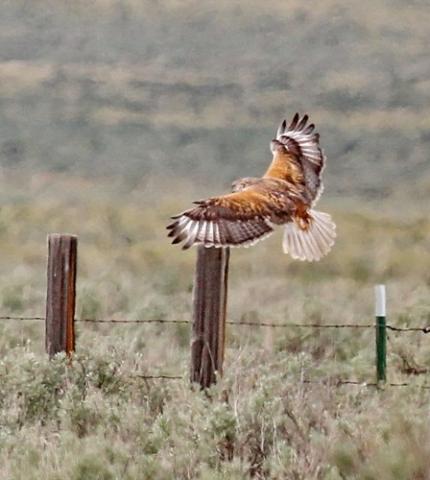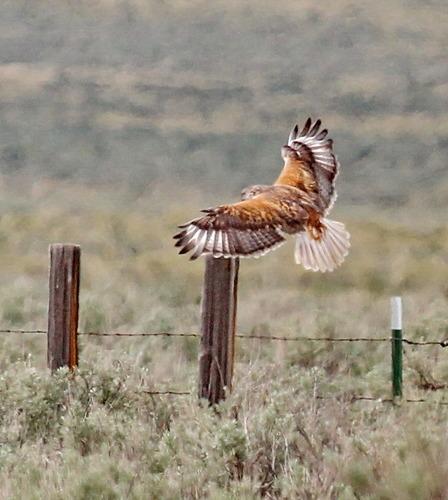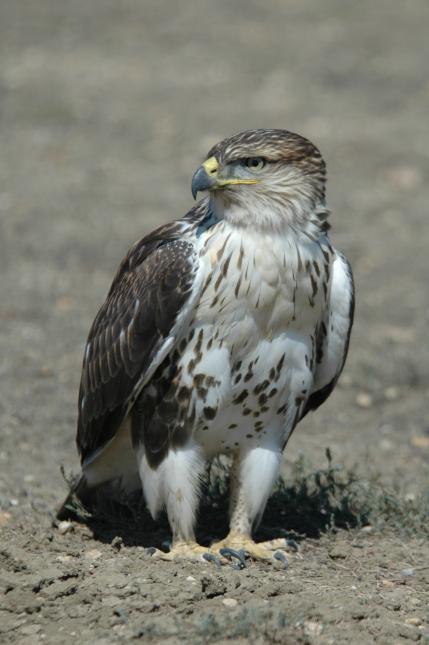Low-
Moderate
The population size of ferruginous hawks in Washington is low. This species is impacted by the loss and fragmentation of shrubsteppe and grasslands from agriculture and residential development and associated declines in distribution and abundance of its primary prey, jackrabbits and ground squirrels. Direct sources of mortality include illegal shooting, electrocution from powerlines, and collision with wind turbines.
Description and Range
Physical description
The ferruginous hawk is a relatively large hawk with broad wings, a large head, robust chest, and feathered legs. This species averages 23 inches in length and has a wingspan of 56 inches. Females are noticeably larger. Males and females have similar plumage. This hawk can appear in two color phases. The light “morph” (phase) is snowy white below, reddish-brown above, grayish head, whitish tail, and underwing linings. The dark morph is a dark brown head, chest, and belly, and whitish tail and underwing linings. Underwing covert feathers are faintly speckled. Toes, "cere" (upper beak membrane), and beak margins are yellow.
Ecology and life history
Ferruginous hawks are migratory and occur in arid grasslands and shrubsteppe habitats.

The diet of Washington ferruginous hawks consists primarily of small to medium-sized mammals, such as jackrabbits, pocket gophers, mice, and ground squirrels, but often includes birds, reptiles, and insects.
This species arrives on its breeding areas from late April through July. Nests occur on small rock outcrops on the slope of steep hillsides or canyons or in isolated trees, such as junipers. The hawks often build on the remains of pre-existing hawk or crow nests. Conservation managers often take advantage of this behavior, providing artificial nests for hawks to build upon to help boost populations.
Following nesting, ferruginous hawks typically migrate to the eastern front of the Rocky Mountains to exploit abundant ground squirrels, followed by a migration to central California.
Geographic range
Washington state is on the northwestern edge of the species' breeding range. Over 200 territories have been documented in Washington, with Franklin and Benton counties together hosting about 60 percent. Grant, Walla Walla, Adams, and Yakima counties have had 13 or more territories each.
In 2002, only 20 percent of historical ferruginous hawk nesting territories in Washington were occupied, with many vacant for years. The current population size is unknown, but likely is very small.
For a map of range-wide distribution and conservation status of this species, check out NatureServe Explorer.
Climate vulnerability
Sensitivity to climate change
Low-
Moderate
Little to no information exists regarding ferruginous hawk physiological sensitivity to temperature and precipitation. Overall sensitivity of this species may be enhanced due to prey specialization (i.e., jackrabbits, cottontail rabbits, ground squirrels, prairie dogs, pocket gophers) and habitat requirements (i.e., grasslands). Warmer temperatures may benefit this species due to grassland expansion. Increased extreme weather events (e.g., heavy rain and high winds) may affect hawk reproduction and survival. Droughts that lead to declines in prey may adversely affect this species.
Exposure to climate change
Low-
Moderate
- Drought
- Increased storminess and winds
Conservation
Conservation Threats and Actions Needed
- Agriculture and aquaculture side effects
- Threat: Loss, degradation, and fragmentation of shrupsteppe foraging habitat and associated declines in distribution and abundance of major prey species, especially jackrabbits and ground squirrels.
- Action Needed: Protect and restore shrubsteppe habitat.
- Fish and wildlife habitat loss or degradation
- Threat: Human disturbance may cause nesting failure and nest abandonment.
- Action Needed: Protect nest sites from disturbance.
- Overharvesting of biological resources
- Threat: Poisoning of ground squirrels; low prey abundance negatively influences reproduction.
- Action Needed: Consider reclassifying some ground squirrels as protected wildlife; public outreach.
See the Climate vulnerability section for information about threats posed by climate change to this species.
Resources
References
Bechard, M. J. and J. K. Schmutz. 1995. Ferruginous Hawk (Buteo regalis). Birds of North America. 172: 1-20.
Richardson, S. A., A. E. Potter, K. L. Lehmkuhl, R. Mazaika, M. E. McFadzen, and R. Estes. 2001. Prey of ferruginous hawks breeding in Washington. Northwestern Naturalist 82:58–64.
Watson, J. W. 2003. Migration and winter ranges of ferruginous hawks from Washington. Final Report. WDFW, Olympia, Washington, USA. http://wdfw.wa.gov/publications/00131/


